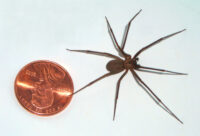Spiders are sometimes found in nestboxes, and a few are venomous. Look before you reach inside! This information is from Keith Kridler, coauthor of The Bluebird Monitor’s Guide to Bluebirds and Other Small Cavity Nesters.

- Brown Recluse spider is very dangerous to humans. They do NOT spin a sticky web, but instead prowl around in search of food. They are normally smaller than 1.5″ across their legs and body. A single bite from them would kill a small baby bird. Their venom begins to dissolve soft tissue and flesh. Antibiotics are used to stop the wound growth.
- Black Widow Spiders are commonly found in nestboxes but they spin a very, sort of haphazard strong web of individual fibers that are “sticky” where they connect to the walls or bottom of a box where insects will walk into the base of the web. They prey mostly on crawling insects. Their venom affects the nervous system and will make a human sick, and may be lethal to a small bird. Despite its reputation, it often attempts to escape rather than bite, unless it is guarding an egg mass or if it is cornered and pressed. The Red Widow Spider is now found in Florida, an imported Australian cousin to our Black Widow. The Brown Widow is mottled brownish. All have the characteristic red hourglass shape on their abdomen.
- A funnel web spider often will use a nestbox. They are not dangerous and their web often plugs up the hole on the nestbox and resembles a dirty gray handkerchief spread outside the nestbox to catch insects falling through the air.
- Jumping Spiders are quite large (thumbnail-size) and look dangerous (almost tarantula) but are apparently harmless to both the birds and humans. They often have a small egg case that is thick and cobweb-like in a box corner or along the edge of the bird’s nest.
MORE INFORMATION:
- Also see info on spider ID
- Problems & Solutions
- Monitoring – How and Why
The bird a nest, the spider a web, man friendship.
– William Blake
